#chlothar alberich
Text
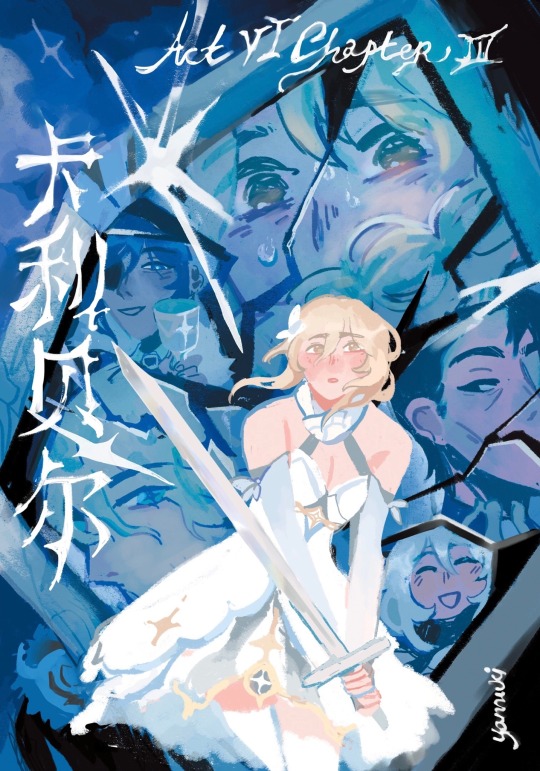
caribert
#genshin impact#caribert#lumine#kaeya#dainsleif#paimon#aether#chlothar alberich#tumblr has finally let me out of shadowban prison so im celebrating by slowly reposting everything i drew since march i guess
1K notes
·
View notes
Photo

“no more red skies....”
alternative title: “ Chlothar and his son Caribert”, inspired by the painting “Ivan the terrible and his son Ivan” by repin, this quest just made me think of it :’)
1K notes
·
View notes
Photo
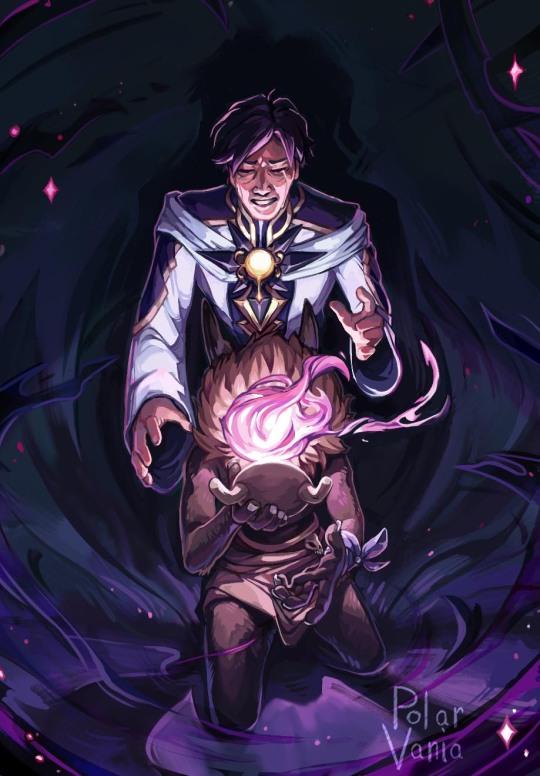
We of the Alberich Clan should lead lives as those who blaze like fire, rather than those who wallow in the embers.
___
The newest archon quest left me emotionally devastated, so this is a tribute to my favorite moments from it :D
I can’t wait until we find out what poor Caribert’s ultimate fate was, as I feel we have certainly not been told all of it...
760 notes
·
View notes
Text
Okay. So essentially.
There are several options.
First, Kaeya refers to Dainslief pointedly as a pure-blooded Khaenri'ahn, because of his ‘eyes’
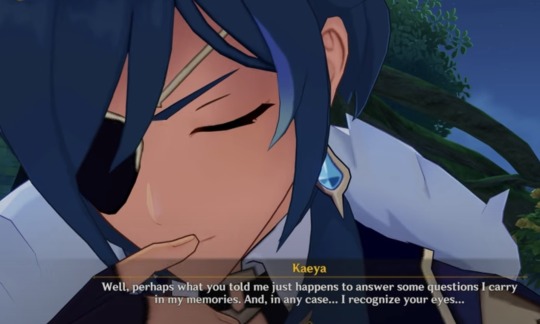
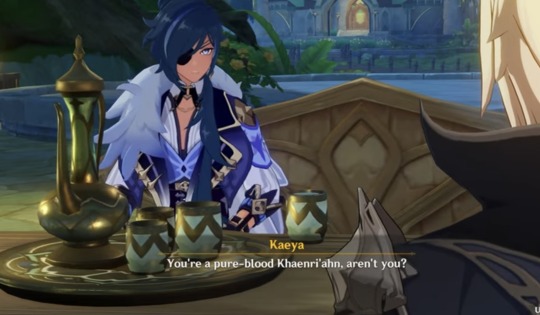
He says this as almost if he is not pure blooded. Unfortunately, that doesn’t confirm or deny. Their eyes are patterned the same, however, so I’m thinking, if Kaeya isn’t solely Khaenri'ahn, maybe that has something to do with the color.


Kaeya's are a dark purple-blue whereas Dainsleif's are more of a lighter teal-blue. Chlothar's appear to be also a lighter blue.

Either way, this isn’t very conclusive. Kaeya could or could not be a pure-blooded Khaenri'ahn. Well except there’s one singular problem. All pure-blooded Khaenri'ahns are cursed with immortality. And as we’ve learned, all non-pure-blooded Khaenri'ahn's were turned into hilichurls. So either Kaeya IS pure-blooded. Or, something very strange is going on with him.
We'll table that for later.
First, we know that Kaeya is definitely a descendent of the Alberich clan- more specifically he says of Chlothar, the founder the Abyss Order.

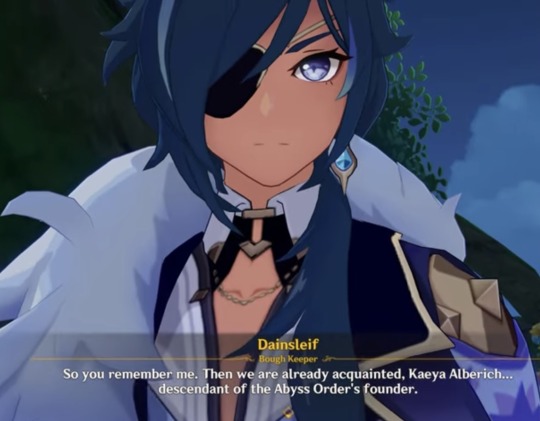
Second, when Chlothar tells you Caribert's identity, he calls him, specifically, his illegitimate son. As if he might have another one floating around somewhere.
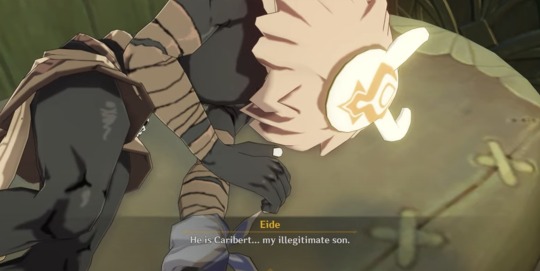
Might he has another pure-blooded son out there? Could he be Kaeya’s ancestor? Maybe. That would also make Kaeya pure blooded, thus immortal, thus solving our problem. That’s one option.
Let's keep going. Another important piece of data is that Caribert's mother is from Mondstadt.

This is only significant because, out of all seven nations to pick from, Kaeya's father also dropped him off in Mondstadt. It could just be a coincidence but, still. It might not be.
Anyway, moving on. I have no theories about what was under Caribert's mask that made him lose it and I truly have no idea why the Sinner's/the abyss's dark energy surrounded him. Either way, however, his fate remains unknown.
Except for this



This seems to indicate that The Loom of Fate is not a thing or a person but some sort of concept/state of being. Either way Caribert is, for all intents and purposes, not here anymore.
The reason I say not here instead of dead is because we have no proof of death. We know Chlothar is dead, but not Caribert.

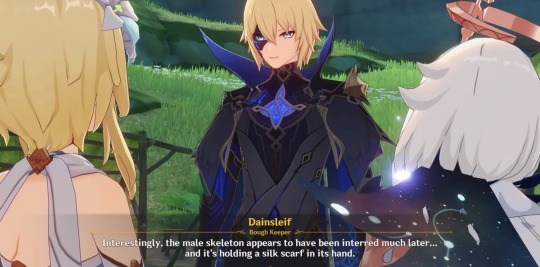

Where does all this leave us?
Well, the first option is the simplest one. Kaeya is the descendant of Chlothar's legitimate child so he is a pure blooded Khaenri'ahn, hence why he is not a hilichurl.
The second option is that he could be a descendant of Caribert himself. As we know, somehow, Chlothar managed to cure his curse of immortality. Maybe that was through whatever happened with Caribert and the Loom of Fate. Maybe Caribert was able to cure himself. Maybe Kaeya is his descendant and thus a non-pure-blooded Khaenri'ahn who is also not a hilichurl.
The third option is that Kaeya is Caribert himself. It makes sense why he was dropped off in Mondstadt. It’s the home of his father's love. Now, the major problem with this one is that it doesn’t fit with what we currently know about the timeline. This occurred hundreds of years ago and Kaeya clearly had a childhood with the Ragnvindrs. I’m not ruling out this option though because Genshin always surprises me.
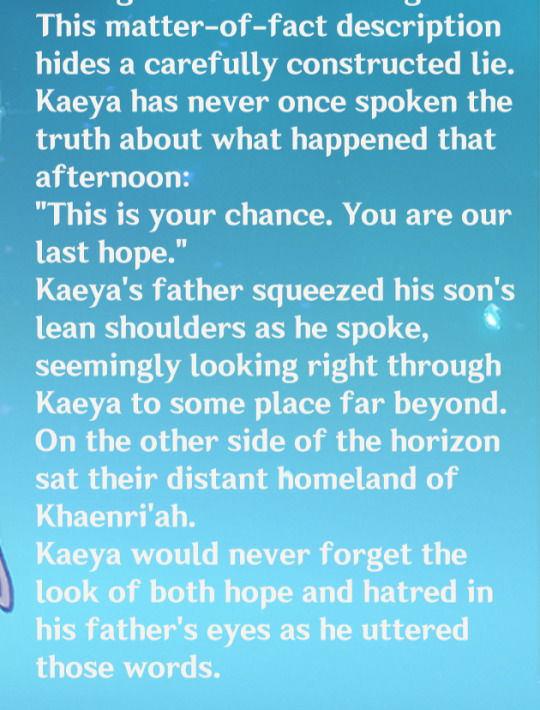
Either way, “You are our last hope” feels very significant here. Perhaps it has to do with the Loom of Fate and why Kaeya is seemingly unaffected by the curse.
#kaeya#kaeya alberich#genshin impact#genshin spoilers#genshin impact spoilers#caribert#caribert spoilers#chlothar alberich#I just needed to have a moment to sort out my thoughts after that quest#I feel like we got almost no answers at all#MIHOYO IM CONFUSED JUST TELL MEEEEEE#dainslief
416 notes
·
View notes
Text
[3.5 analysis] The Uncanny, Fate, and the Machine

In Genshin Impact, machines and automatons matter. They are everywhere in the world, from small devices and gadgets to hulking, imposing mountains of metal created for the purpose of war. I wanted to know what happens when we look at these machines through the lens of the uncanny in hopes of better understanding their narrative purpose. It turns out, machines tell us a lot about the plot's direction, from smaller stories like Karkata, Benben, and Tamimi’s relationship to humans, to the larger story of the twins landing in this strange world. This theory will deal with the larger story by applying the uncanny to the Akasha, Irminsul, and the Loom of Fate.
SPOILERS: Caribert (and all Sumeru Archon Quests preceding it, basically), Inversion of Genesis, Aranyaka (Aranara world quest), Alhaitham’s Story Quest (like two screenshots), two of Faruzan’s hangout endings, and one out of context screenshot from 3.5’s Windblume.
DISCLAIMER:
A part 0 to this can be found here, which was produced along the way to writing this theory. It is not absolutely necessary to understand the points in this post, but might be of interest if you liked the psychoanalysis bits and want to take a closer look at the meaning and significance of dreams.
All external sources will be listed at the bottom! If digital, they are linked. If print, the title and author are given.
The Uncanny 101
To be clear, this theory won’t be overly reliant on the psychoanalytic perspective of the uncanny, but I think Freud is a good place to start in order to get to where we need to go. If you’ll indulge me for a moment…
In his essay Das Unheimliche (1919) [The Uncanny], Freud proposes the psychoanalytic significance of the uncanny by first examining its linguistic meaning and then by applying it to literature. In order to fully understand the uncanny (unheimlich), Freud argues that we must first understand heimlich. We will follow suit. Heimlich has two common meanings, and we will start with its first meaning.
Heimlich’s most common meaning denotes familiarity, “belonging to the home,” homely, tame, and intimate. The literal translation of heimlich to English is also “of the home/house.” Seems simple enough. It is something pleasant and familiar.
But, heimlich's second meaning complicates this definition. Heimlich in this second context is “concealed, kept from sight, so that others do not get to know about it, withheld from others.” Secret. Private:
“To do something heimlich, i.e. behind someone’s back; to steal away heimlich; heimlich meetings and appointments; to look on with heimlich pleasure at someone’s discomfiture….to behave heimlich, as though there was something to conceal; heimlich love, love-affair, sin; heimlich places (which good manners oblige us to conceal)” (Freud, 3).
I like to think about heimlich's two meanings as a matter of perspective. Imagine that you are in a house in the middle of an unfamiliar place with your loved ones. The feeling of being together in this familiar, intimate setting puts you at ease. This is the first meaning of heimlich. As the days go by, you settle into the monotony of your routine within the house's walls and begin to wonder about what is outside of the house, concealed from your sight. This is the second meaning of heimlich.
The reason this difference in meaning is interesting to us is because unheimlich has only one use and meaning, and that is strange, unsettling, eerie:
“‘Unheimlich’ is the name for everything that ought to have remained . . . hidden and secret and has become visible,” (Freud, 4).
In other words, unheimlich means the opposite of the first definition for heimlich, but it is synonymous with the second meaning. In this way, what is heimlich is also unheimlich. What is familiar is also strange. What is of the home is also outside of the home. But how can that be?
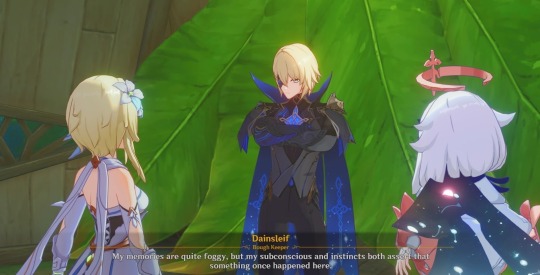
Dainsleif: My memories are quite foggy, but my subconscious and instincts both assert that something once happened here.
Central to Freudian psychoanalysis is the notion that both traumatic and non-traumatic memories and thoughts we experience throughout life, but especially those experienced as children, are forgotten and repressed in the unconscious, censored from the ego's perception. Freud thought that even if we cannot immediately recall these things, they do not simply disappear from the psyche.
The process of repression, which relegates these formerly conscious or “preconscious” thoughts to the unconscious, makes something that was once familiar to us, in this case a thought or belief, feel strange and unfamiliar upon its resurfacing. Freud argued that this is the true nature of the uncanny. It is why uncanny feelings are characterized by dread and anxiety - because the object or story or phenomenon triggering the memory's resurfacing reminds us of something we once knew intimately, but that has become unfamiliar through repression and distortion.

Alhaitham: However, these memories aren’t truly lost, but merely sealed away. They can be restored with the appropriate stimulus.
The uncanny, then, is characterized by a return of the repressed, a recursion or repetition if you will. This was quite long-winded, but the most important takeaway here is that the boundary between the uncanny and the familiar, the unheimlich and heimlich, would seem impermeable on the surface but is in fact fluid and changeable. With time, things that were once familiar and pleasant can become strange and unsettling.
An example might help here. Let’s take a line from A Drunkard’s Tale, an in-game fictional book (credits to Tuna for this example, which I would not have thought to analyze with the uncanny without having read their observation thread on Caribert):
“What you humans call wine, we wolves call the Abyss.”
There is a sentence in Freud’s essay that has a very similar structure to this one, printed here:
“We call it unheimlich; you call it heimlich” (Freud, 3)
Or, to more closely mirror the structure of the quote from A Drunkard’s Tale:
“You call it heimlich; we call it unheimlich.”
So, let’s break this up and analyze it in parts:
“What you humans call wine/You call it heimlich.” Wine is a “known” thing, it is a product from an ordered world with rules. We know how it’s made and what effects it has when consumed. It “belongs to the home,” the “home” being an abstraction of all that is familiar.
“We wolves call the Abyss/we call it unheimlich.” Unheimlich is something strange and unfamiliar, a feeling of dread, but it is synonymous with the second meaning of heimlich, a word most commonly denoting what is familiar. The Abyss is "beyond this world," it is everything that exists outside of the boundaries of “Teyvat.” So how can the Abyss even be compared to wine? Maybe because there isn’t as big of a difference between them as we would initially think. The quote is asking this question: how can the Abyss be something beyond this world/outside of it (unheimlich) when it’s right here in your very human/Teyvat things (heimlich)?
Or, if you’ve ever experienced the sensation of déjà vu, that’s also an uncanny feeling. Speaking of déjà vu…
Recursion, Repetition, Samsara
“We think we are creating the system for our own purposes. We believe we are making it in our own image... But the computer is not really like us. It is a projection of a very slim part of ourselves: that portion devoted to logic, order, rule, and clarity.” -Ellen Ullman, Close to the Machine: Technophilia and its Discontents
One of the many machines we became acquainted with in the Sumeru Archon Quest was the Akasha. The Akasha was advertised as an access point to knowledge from Irminsul, but in reality it was a dream-harvesting machine unevenly distributing “bundles of human wisdom” to the terminal-wearing Sumeru populace in exchange for their dreamless sleep.
We know how the story goes: Nahida leads us to the truth of the samsara in Act II by having us make associations about our strange environment ourselves - a process that takes inspiration from Freud’s method for dream interpretation, free association (more on that here). She does this because delivering the truth to us without having made these connections ourselves would “blow our minds,” permanently confusing our sense of reality and dream. Basically, she has us do the opposite of repression - we take information from our strange environment, associate it with things we are familiar with, and arrive at the answers on our own. This exercise helps us understand the hidden truth of the Akasha, a secret concealed by the Akademiya’s sages.
To take our understanding of this a step further and connect it to another angle of the uncanny, I want to turn our attention back to the first meaning of heimlich, specifically how it describes things “belonging to the home.” Another English word for this would be domestic, things pertaining to the house and running the household. Familiar things. All other things outside of the house, like the wilderness, the foreign, would be unheimlich. As we’ve established earlier, the line between these two categories is changeable. Things previously regarded as domestic, belonging to the home, can become unfamiliar with time.
There is a lot we can do with this, but let’s focus on its applications to the Akasha first. Aranaga actually takes a very similar approach when explaining its function in Agnihotra Sutra:

Aranaga: Here, Aranaga's remembrance, is this flower. Cannot blow him away, the Ad Oblivione; cannot destroy him, the device that takes away dreams.
Traveler: The thing that takes away dreams...?
Aranaga: The living memory of nature, dream. Man-made dead thing, mechanism. Taking away living memory, grinding and crushing to extract its juice, like a grinder, for dominion and domestication... Don't like this, Aranara.
Paimon: Eh... Why?
Aranaga: Because the garden of freedom, the source of power, dreams and memories, not only for Aranara, but also for Nara. But Nara don't know. Not good action... extraction, grinding.
Aranaga: Memories and dreams are gone, reason for action is gone, strength is also gone.
Domestication is the process by which things “outside of the home” are brought “inside.” In human history, we can observe this process through the domestication of crops, livestock animals, dogs, and so on. What was once wild and outside the realm of human control is tamed and cultivated within the boundaries of the city center. Domestication has a greater purpose: to extend civilization’s power and control over what is “outside” by controlling its reproduction.
It’s an apt description for the Akasha under the control of the previous sages - it was a Dream Domestication Machine, bringing a “source of power” within the Akademiya’s control in order to populate the Akasha’s records with knowledge. Eventually, it would also be used to attempt to create their own mechanical God, in hopes of bringing a sliver of divinity within human control. In essence, the sages made the strange (dreams) into the familiar (a power source). Domestication, then, is the inversion of repression and the uncanny.
We can see this in the Akasha’s predictive capabilities as well. Given enough information, the Akasha can use behavioral logic to predict (though not dictate) the movements of a person, but only to a certain point. Its ideal subject was someone like Cyno before the Archon Quest - a “decisive and principled person,” someone who prefers to operate independently of other people and their behavioral logic, which can muddy and change our own. Cyno’s behavior was once predictable and familiar to the Akasha’s algorithms, but by changing his behavior he became unreadable, unfamiliar, and strange, if temporarily.
“A Flower Not Of This World”
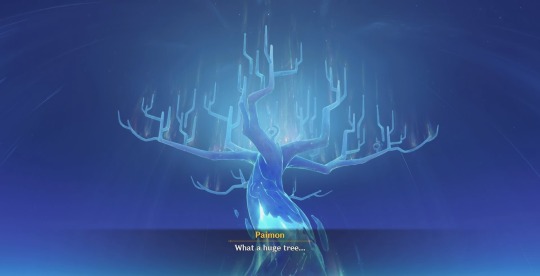
Considering the Akasha was made by the Dendro archon, whose origins lie in Irminsul, and the copious foreshadowing in Act II’s samsara for the resolution of Inversion of Genesis, it is not outlandish to view the Akasha as an analog to Irminsul. Though they may not function exactly the same way, we can already observe that Irminsul behaves more like a machine than something biological, what with Nahida functioning as a sort of system administrator to it (with limited privileges, it would seem…), its use of system permissions, its virus vulnerability (forbidden knowledge), its strictly literal interpretation of commands executed to its database...you get the picture.
So what is the purpose of this arboreal machine? And what are the rules?
While the intimate details of Irminsul are still murky, including who all can control it and who made it, we do know a few important things about it:
It contains a record of everything that has happened in Teyvat in the form of collective memories. It acquires memories through the Ley Line network, which stretches all over Teyvat, and records information as it happens. It also seems to acquire the memories of those who pass away - it is repeatedly stated in Aranyaka that everyone “returns to Sarva” when they pass.
It can alter memories of the past when edits are made to its database. We have two known instances of this so far, both of which are deletions: the removal of the memory of Rukkhadevata, and the removal of the identities “Kabukimono” and “Balladeer.”
The Traveler's memories are not affected by edits to Irminsul because they are not of this world. This is because of the truth hidden by Irminsul’s records - it contains no records of “descenders,” because to do so would be to admit that the sky is fake.
Deleted memories are not lost forever if necessary precautions are taken. While non-fiction books, quest dialogue, domain descriptions, and other quest items are altered by Irminsul edits, fiction is outside of its reach. Nahida understood this intimately, so she hid the true history of the Wanderer in a fairy tale story, which was her own unique form of distortion independent of Irminsul’s distortion. This allowed her to freely associate the elements of the fairy tale back to the truth, just like what we did in Act II to arrive at the truth of the samsara, and just like what Freud had his patients do to interpret their dreams. Through this, she resurfaced her memory of the truth.
Returning to the idea of the uncanny and the familiar, what happens when we think of Teyvat as a “home,” and everything considered separate from it (like descenders, the abyss, or forbidden knowledge) is the uncanny, outside of this world? The utility of Irminsul becomes clear: it delineates the boundaries of “Teyvat” so as to maintain a closed system of memory production in its inhabitants.
Another way to look at Irminsul, then, is as a Memory Domestication Machine. This analogy requires us to stretch the definition of domestication as not only involving something under human control, but it still functions the same way.
It’s important that we understand the rules of this machine and familiarize ourselves with its boundaries - only then can we understand its limitations and exploit them:
Alhaitham: You may find it hard to believe, but for those people, everything the Akasha transmits to them is nothing short of absolute truth.
Alhaitham: Imagine if you've been using a device like the Akasha since the day you were born. And this device has always supported you during times of need...
Alhaitham: After all that time, what do you think you'd become?
Paimon: Uh... A fool? A machine?
Alhaitham: A slave to orders. And that's why rules are so important. In addition, those who understand the rules can delineate boundaries, and identify gray areas.
Paimon: Hmm... but why would you need to identify the gray areas?
Alhaitham: You could say that those kinds of ambiguous zones can be very interesting. One might even say they're advantageous in the right hands…
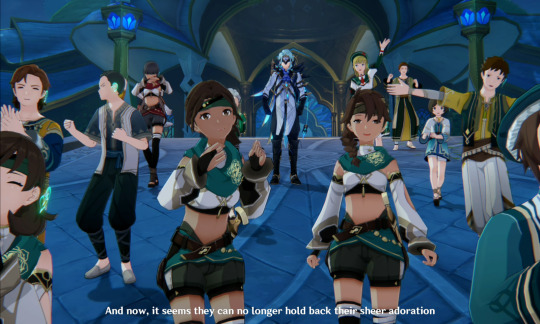
Dottore: And now, it seems they can no longer hold back their sheer adoration..
Under the dominion of the Akasha, the line between human and machine was blurred. The same can be said for Irminsul – even alterations to its records produce the same fates with different recollected details, further calling into question the notion of free will under Teyvat’s laws. In the real world, we use the Turing test to measure a machine's ability to imitate a human, but the Akasha and Irminsul turn this idea on its head - are humans, in fact, the machines here?
If free will is an illusion, then one perspective might posit that human lives in Teyvat are no better than programs running to completion. It’s part of the irony that the remnants of Khaenri’ah’s technology are humanoid automatons (“Machines of war built in man’s image”). Whether or not that perspective is correct is for you to decide.
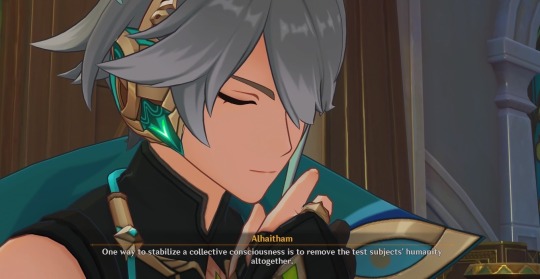
Alhaitham: One way to stabilize a collective consciousness is to remove the test subjects’ humanity altogether.
(look, I’m not saying Irminsul is a machine with an Overmind using it to create a collective unconscious, but that is also what I am saying).
Although it can change how the past is remembered, Irminsul has to abide by fate. Considering that the Akasha had predictive capabilities and is an analog to Irminsul, we might be tempted to ascribe predictive capabilities to Irminsul as well. It’s not outside of the realm of possibility. But, I think what is more likely at this stage is that Irminsul and the Ley Lines are just parts of a greater system of machines delineating Teyvat's boundaries, and one of those machines has dominion over fate.
One last piece of information we gained from the Sumeru Archon Quest was that the Traveler’s sibling is recorded in Irminsul. The Wanderer states that “[the sibling] only came to this world because the heavens responded to the summoning,” that Khaenri’ah was their first destination upon arriving sometime before the Cataclysm, and after which they traveled the Seven nations before their fate became “deliberately obfuscated” by “someone.” Now, they are running the Abyss Order.
At the end of "Akasha Pulses, the Kalpa Flame Rises," Nahida told us this:
Nahida: There's only one possible explanation: [they] belong to this world.”
But Nahida’s wording here is very important. It reminds me of Sucrose’s philosophizing about the prophecy Collei found in this year's Windblume:
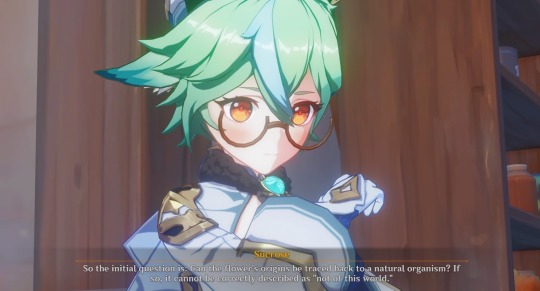
Sucrose: I was thinking about the flower that is "not of this world." It could mean a human-cultivated variety that doesn't occur in nature... But that's basically claiming that it doesn't come from this world in the first place, when actually it's just a variant of an existing breed.
Sucrose: So the initial question is: Can the flower's origins be traced back to a natural organism? If so, it cannot be correctly described as "not of this world."
Sucrose: But then... supposing we identified something outside of that category, whose job would it be to decide whether it belongs in this world or not? Then the question becomes: Do "of this world" and "from this world" mean the same thing... or is it deeper than that?
The heimlich and unheimlich are divided by a permeable, fluid boundary. While there is absolutely still room for more plot twists regarding the Abyss Sibling’s origins, for now I think the additional information we have about their arrival to Teyvat simultaneously contradicts and supports Nahida’s initial hypothesis. The Abyss Sibling may indeed not be from Teyvat, just like the Traveler, but that does not preclude them from being brought into the boundaries of Teyvat through an unknown method of tampering with Irminsul, so that they now belong to Teyvat and are “of this world.” I mean to suggest that the Abyss Sibling was domesticated into Irminsul’s memory, and therefore into the boundaries that delineate Teyvat. How exactly, by who, and for what exact purpose is currently unclear. But if I were to guess….
The Uncanny and the Abyss

Chlothar: To us, you were the Abyss…a wondrous mystery far beyond our imagination and comprehension…and the one who controls the Abyss can control everything!
So like…we need to talk about Caribert.
In Chlothar’s despair at having failed to recover Caribert’s consciousness, the Abyss called out to him and opened a strange domain near Sumeru’s entrance to the Chasm. Once there, he and the Abyss Sibling discover a mysterious hanging crystal which whispers about a power the bowing Hilichurls and Chlothar covet. This power, which Chlothar understands as the Abyss, does indeed resurface Caribert’s consciousness, but it comes with a price. Chlothar’s obsession with the crystal steers his attention away from his son, who in child-like wonder gazed upon his maskless reflection in a hand mirror, only to discover the horror of reality: this is not a fairytale world like his father said, he has really become a Hilichurl, his home has been obliterated, and there is no going back to life as he once knew it.
So, he rejects his fate and removes his mask one final time, unleashing a dark power that engulfs his body. Though the player passes out at this moment, Chlothar later says something cryptic regarding his son, who has now vanished from sight:
Chlothar: You saw it too, didn't you? Unmistakable... The power inside Caribert and the power of the one you call a "Sinner," it was one and the same...
Chlothar: I am positive now... it's the power of the Abyss, isn't it?
Chlothar: At long last, I have seen it with my own eyes...
Traveler: I didn't see clearly...
Traveler: What happened to Caribert?
Chlothar: That is no business of yours!
Chlothar: A sinner... Yes, salvation for a sinner can only come from a sinner...
Chlothar: Caribert did not deserve his fate, but now... It's wonderful — he will be able to weave his own destiny anew.
Chlothar: Born into abject sorrow, he shall now become... "The Loom of Fate."
There is a LOT in this dialogue to unpack. First, let’s talk about what happened to Caribert. Though we do not see it ourselves, Chlothar says “salvation for a sinner can only come from a sinner,” and that now Caribert can weave his own destiny anew. He also states that he has never seen the power of the Abyss before now, but I also wonder if he is saying he has never seen the Loom of Fate’s power with his own eyes before. To me, this suggests that Caribert fused with the Abyss, or even with the Loom of Fate (assuming these two are separate things to begin with).

Then, Chlothar says more strange things about the Abyss Sibling:
Chlothar: ...Sinister? ...Dangerous?
Chlothar: I never imagined that you, of all people, would deny the Abyss... How ridiculous!
Chlothar: We once believed that you would bring new strength and hope to Khaenri'ah.
Chlothar: To us, you were the Abyss... A wondrous mystery far beyond our imagination and comprehension...
Chlothar: ...And the one who controls the Abyss can control everything!
Chlothar: We yearned for that future. We looked to you to take us there.
Chlothar: But what did you bring us instead?
Chlothar: O Prince... of Khaenri'ah?
Remember how in Inversion of Genesis, Wanderer told us that the only reason that the sibling was able to come to Teyvat was because “the heavens responded to the summoning?”, and the Traveler immediately suspected that Khaenri’ah had to do with the sibling’s appearance in Irminsul’s records? Yeah, well. I'm not exactly saying they summoned the twins, but they clearly were up to no good once they encountered the sibling.
“To us, you were the Abyss.” The Twins are external to the laws of Teyvat, making them unknown, strange, and unfamiliar to this world. Chlothar’s dialogue suggests to me that Khaenri’ah has been seeking a power from beyond for a long time now. My speculation is that Khaenri’ah has known for a while about this “Loom of Fate,” but could never prove its existence. The Loom of Fate is likely what materializes fate into reality, if it does not also dictate fate, and it seems to be located in the Abyss itself. A loom is a wooden machine of sorts, used to hold thread or yarn taut as the user weaves them into cloth or tapestries. This is the machine I suspect Irminsul is working with as a system. Whether the Loom of Fate is a “Fate Domesticating Machine” is unknowable for now, but surely we can conclude that the Loom of Fate Operation is a fate domesticating mission. Perhaps they sought to control the Loom of Fate through the sibling. Perhaps they hoped to do so in order to change their own fate, as ignorant beings ruled by a cruel order imposed by the heavens above.
One final, somewhat tangential remark I’d like to make is about the name of the Hilichurl curse, the “curse of the wilderness.” This again gestures toward the idea of a home place and a wild place, what belongs to the home and what is outside of it. Something tells me from the last quest with Dainsleif in the Chasm that Hilichurls do not go to Sarva when they die, they disintegrate into the dark mud of forbidden knowledge. The curse casts them “outside” of the cycle of life and death, outside of the memory production system, and outside of fate. Though they are still from this world, in a sense they no longer belong to it either.
A Companion Machine Manifesto?

Faruzan: As for me…I want to stay with Tamimi for a bit longer. Just a bit.
I don’t want to get too into it now since this post is already too long, but it would be normal to wonder after all of this what to do with these boundaries at the center of Genshin’s world structure and conflict. We can’t just get rid of them all – King Deshret already tried that, and it didn’t work out so well for him. For now, when I think of the answer to this question, I can’t help but think of Karkata, Benben, and Tamimi, and their unique relationships to humans.
To be honest, they are what originally got me thinking about domestication as a way of reading Genshin’s worldbuilding. They participate in mutualistic relationships with the humans around them, living together in what feminist scholar Donna Haraway calls a relationship of “significant otherness.” As automatons that belong to lines of machines designed for war, their difference seems significant. I don’t have the precise language for this yet, but when I think of these care-full relationships they share with Tighnari, Jeht, and Faruzan, I can’t help but feel hopeful that things can change.
If you’ve made it this far, I truly from the bottom of my heart thank you so much for reading <3 Until next time!
External Sources/Further Reading
Das Unheimliche by Sigmund Freud, translated by Alix Strachey.
Against the Grain: A Deep History of the Earliest States by James C. Scott.
The Companion Species Manifesto: Dogs, People, and Significant Otherness by Donna Haraway.
“The Uncanny Familiar: Can We Ever Really Know a Cat?” by David Wood (this is amazing btw).
…Okay but the wild part is this is the second post I’ve made about the uncanny since this idea was born in September and I STILL HAVEN’T WRITTEN THE POST I WANT TO WRITE YET. When I get back from my thesis hiatus, we are talking about the ‘bots. And I mean ALL of them. And Dottore. And the Golden Slumber!!
edit 6.16.23: cleaned the post up! edited sentences for clarity, added to some unfinished thoughts, and re-formatted a few things that got lost between gdocs and tumblr. also grammar is hard :[
#genshin impact#genshin lore#genshin impact lore#genshin meta#caribert#chlothar alberich#dainsleif#irminsul#loom of fate#faruzan#theory#I will stop writing about machines when the sun explodes
234 notes
·
View notes
Text
Wow, Caribert was short as an Archon Quest but had a lot to unpack. The Alberich lore, the introduction of the Sinner, the reveal of pure Khaenri'ans being considered 'sinners' (potentially Rhinedottir since she's referred to as the Great Sinner of Khaenri'ah . . . Albedo what aren't you telling us), the flashback to the Traveler's twin's introduction to the Abyss, and the way Chlothar broke the curse . . . I have so many questions about what's going to happen next, I am not ready. The plot twists were insane and I've got more questions than answers, damn.
#genshin impact#caribert#kaeya alberich#genshin impact spoilers#spoilers#chlothar alberich#khaenri'ah#the abyss#genshin impact lore#genshin impact theory#rhinedottir#albedo#dani.txt
120 notes
·
View notes
Photo

God forbid they use any of the millions of dollars they get from the banners to put some effort into characters that aren’t playable!
Also RIP to the “Pierro is Kaeya’s dad” theory! My condolences!
#genshin impact#caribert#genshin 3.5#genshin spoilers#genshin 3.5 spoilers#genshin caribert#genshin caribert spoilers.#chlothar alberich#genshin version 3.5
136 notes
·
View notes
Text
ok this should NOT be bothering me as much as it is but can someone pls help me figure out wtf is going on with chlothar's underground jordan 33s?

Is it like,,,,two layers of sock?

Is it one layer of sock and the shoes are ankle high?
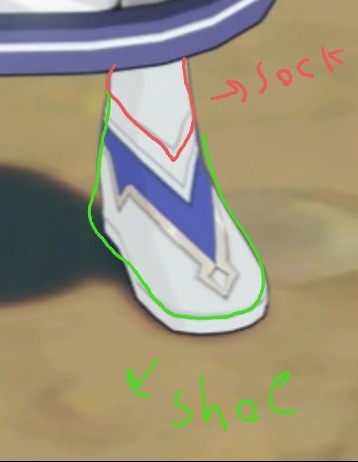
Is he wearing fancy slippers?
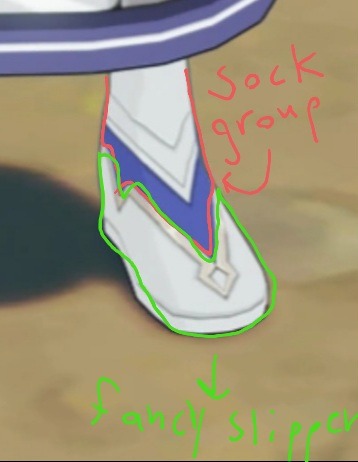
Is the "slipper" actually a boot and everything above it is actually over it like a sort of armor

Or is the whole thing a multicolored boot???

PLS AM I JUST STUPID OR WHAT I'VE BEEN STARING AT HIS GRIPPERS SINCE 3.5 TRYING TO FIGURE IT OUT
#asking because I need to analyse khaenri'ahn clothing in as much detail as possible no im not obssesed im just a lore player#khaenri'ah#khaenriah#genshin#chlothar alberich#I should be studying btw#shitpost#genshin impact
19 notes
·
View notes
Text
I wish genshin would pull some disturbingly horrifying stuff that makes chills go down my spine like the caribert quest again
#genshin impact#genshin characters#caribert#chlothar alberich#khaenri'ah#angst#creepy#scary#i want genshin to be even more horrifying#pretty pleaseeee#hoyoverse#mihoyo#kaeya alberich#kaeya#genshin kaeya#hilichurls#the sinner#dainsleif#the abyss
52 notes
·
View notes
Text

some #rkgk i made after finishing 3.5 archon quest
#lumine#kaeya#dainsleif#kaeya alberich#chlothar alberich#dainkae#dainslumi#kaelumi#genshinimpact#genshin fanart#genshin angst#archon quest#khaenriah#eide#caribert#doodles#semirealism#grayscale
88 notes
·
View notes
Text
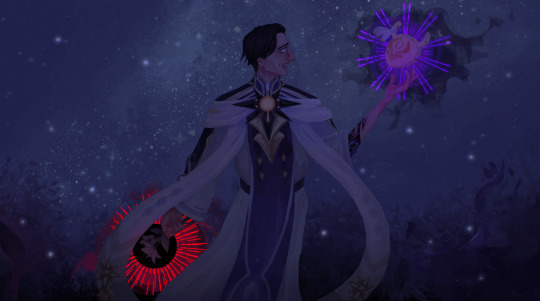
abysmal sorrow
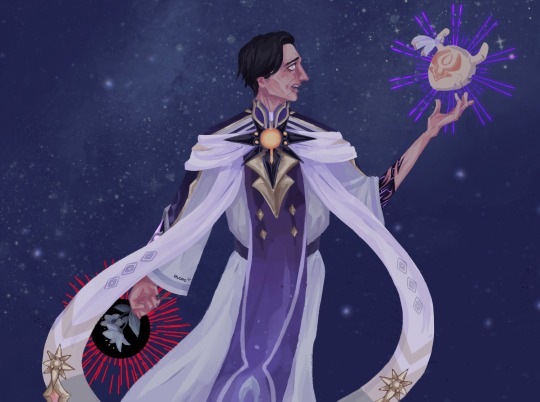
50 notes
·
View notes
Text
Hexenzirkel’s students/successors:
(confirmed)
- Mona and Barbeloth
- Klee and Alice
- Albedo and Rhinedottir
- Scarlett and Ivanovna
(speculative)
- Nicole and Lisa? (who seems avoidant of the Hexenzirkel)
- Andersdotter and Razor?
- [Ragnvindr ancestor] and Diluc? (red tea set)
- [C— Alberich’s lover] and… Kaeya?
There were eight portraits around the circle, but seven seats, so perhaps someone disappeared before the tea party pact. It would explain their motives for going against Barbatos.
I think it was Kaeya’s Mondstadt ancestor because something had obviously happened to her during the cataclysm. She wasn’t cursed, but buried sometime before Chlothar Alberich could break his immortality.
And maybe the blue vase and starry flowers were in her commemoration.
#hexenzirkel#rhinedottir#barbeloth#chlothar alberich#luckae#kaeluc#kinda in a poetic sense#andersdotter#ivanovna#genshin theory#all speculation btw#I also like the theories about damselette and skirk being hexenzirkel#I was partially considering the GAA events and who Alice seems to keep tabs on#could barely decide between andersdotter being more related to lisa or razor#the red tea set and blue vase actually represent Diluc’s and Kaeya’s Hexenzirkel ancestry (real)
44 notes
·
View notes
Text
kaeya crack theory
ok so kinda random theory about kaeya I thought of the moment I stepped in my house lol but ok so:
Chlothar has an illegitimate son, Caribert yes? what if he also had a legitimate son? I’ve seen others think this, but I also added another thought.
What if his legitimate son was actually trying to oppose the abyss? We know kaeya is related to Chlothar, but we don’t know how exactly. Son, great great great ect son? I was thinking that kaeya could be a descendant from his legitimate son that could be trying to oppose the abyss.
Kaeya clearly is at least 82% human so I assume he is a descendant of a pure blooded Khaenri’ahn that had kids after the cataclysm, meaning the curse probably would not affect him. (speculative but I cannot think of any other reason why he seems not affected)
Mona’s voiceline about kaeya could be talking about how his choice in the future is to leave Mondstadt and stop the abyss, possibly dying in the process, or stay and potentially have the abyss destroy Teyvat.
In the weinlesefest festival, we hear Kaeya’s dad tell him that this is where you must stay, you are our last hope, forgive me, Kaeya. and he sounds somewhat sincere.
What if the descendants or even the actual legitimate son (he would be presumably pureblood and cursed so he could have lived long enough to have Kaeya) tried again and again to destroy the abyss, but were not able to? And their last hope is using Kaeya somehow. Not sure how exactly, but they must have a plan.
RANDOM THOUGHTS I HAD and needed to write down, this is all me trying to speculate how Kaeya is related to Chlothar and what the ‘last hope’ is :P
#kaeya#chlothar alberich#caribert#genshin#genshin theory#genshin impact#RANDOM THOUGHTS LMAOO this is kinda /hj but also not ? idk#im kinda stretching but its 7pm and i just came from a life drawing session my brains tired <3
32 notes
·
View notes
Note
helloo i just stumbled acress your blog and if you dont mind id like to ask-
FELLOW GENSHIN LORE FAN????
if yes then what are your thoughts on the next dain archon quest-
feel free to ignore/not answer btw, no pressure ^^
FUKC YEAH LOORREEE
I’m more into Khaenri’ah/Abyss lore, than anything else tho, if i’mma be honest lol.
I’m absolutely interested in lore and stories and general though to be honest I think my attention span and sleep deprivation doesn’t allow me to make up anything to big from scratch
Σ(-᷅_-᷄๑)
But I’d love to bounce of others if it weren’t for my social anxiety so please I’d be absolutely interested in anything with this
I’m really late to answering this shit to where people have already posted the cutscenes of Caribert onto yt, which I watched because impulse control is a myth and I’m quest locked so-
If you haven’t seen it yet then by all means ignore the rest of my rambling;
So Kaeya is specifically the descendant of the founder of the Abyss Order, Chlothar Alberich. Kae outwardly says he has no idea of the origin, with how openly he handles his last name, but he also says it ties up some questions he’s had.
Of course, quote Diluc, “you can only trust half of what he says at best,” so of course taking that with a grain of salt:
At ‘worst’ that means Kae always fuckin knew/This is just the final confirmation about it, and he knows a lot more about the Abyss Order. (Also funfact: one of his first, base lines, like the ones you have access to w/ friendship lvl 1, have something asking “Is the Abyss Order bothering you?” Not to mention there’s an anecdote on “You’re scars of the dark? That’s… interesting.” Oh, and that first archon quest in the domains and stuff; Where Kaeya recognizes hilichurl aren’t this smart and looks like he’s about to talk with a Abyss Mage before adult barges in. And the. “Let’s just say I was blessed with certain… linguistic powers.” Shit, foreshadowing goes deep.)
At best: He had just a bit of knowledge about it, and confirmation opens a lot up for him.
I do doubt he’d actually turn to the Abyss Order, cause Hoyo making him essentially a villain/major (enough) antag would be… uh, unlikely to say the least. I can see some spying on the Abyss Order and double crossing them though, that fits with Kae.
And at the same time, Caribert is apparently Chlothar’s son, right? He’s obviously affected by the curse, being the hilichurl. And so if we’re going with the “Kaeya is from straight up alive Khaenri’ah, not just the ruins” that either means through shenanigans Caribert turned into Kae or Kae has a sibling.
However, Kaeya is called a descendant of Chlothar, so that’s a separation of time; But then that also brings up the question of how Kaeya knows of Khaenri’ah? His Story says things/describes Khaenri’ah in things in general that paints it as if he actually lived there.
Did he live in ruins? Then I doubt he’d have as much knowledge about Khaenri’ah as he could very well likely have (and not tell us, obviously, the little liar [affectionate]). Not to mention the paper he stole when his father showed him about “what being an Alberich” is about and stuff; embers blah blah; that doesn’t sound like ruins…? Ugh. He has a stupid amount of 4-pointed stars on his design too; There is no way he doesn’t know at least a good amount about Khaenri’ah.
Following the Caribert -> Kaeya thing;
Chlothar did fuck around with the Abyss sibling (I play Aether so I’m gonna say Lumine) to try and find a way to help Caribert with the curse and stuff. Hell, after we dig up the bodies when Dain wakes us up, Dain questions if Chlothar found a way to stop the curse or something. So perhaps Chlothar did “cure” (to some level, otherwise they wouldn’t need to do the Loom of Fate shit) of some sorts that returned Caribert?
And then due to Abyssal time shenanigans (it’s already proven to fuck with time, look at Ajax/Childe) memories got fucked and Chlothar decided it’d be best to leave Kaeya in Mond, whether as a spy or for a better life? Kaeya does still have that eyes patch, after all. And it’s not implausible that there was a name change for ambiguity.
But at the same time, a ‘cure’ for the curse would be questionable - why hasn’t it been mass produced/practiced by now then? - not to mention I don’t think Kaeya would only get away from all that with just an eyepatch covering his face. And again, Kaeya was described as a “descendant” of Chlothar, and it’s referred to as an “ancestor/ancestry” specifically, so for the time thing it’s unlikely.
Not to mention, Chlothar also has a bigger star, closer to Dain than Kaeya’s. As Kae put it “pure-blood Khaenri’ahn”.
So yeah, Kaeya is probably just more of a descendant, if his appearance contradicting the description of a Khaenri’ahn has to say anything (“Light hair, fair skin, star-pupil” Kae is one of the 3 playable characters that has a darker skin tone, he has dark blue hair, and his star pupil is small than compared to Dain or Halfdan. …Though Chlothar has black hair. Huh).
But bring up the fact that he describes Khaenri’ah like he’s lived there and the. That brings up and entire other question/argument. Then what was Kaeya’s father, Chlothar or not, doing? Was he part of the Abyss Order? Or was it just something purely Khaenri’ahn? How is he not affected by the curse; was it the fact that he’s only part Khaenri’ahn?
So much questions so little information. This is the reason I love and hate lore aaaaaaa-
Okokok
Caribert & Kae are siblings? - Again the “descendant” and “ancestry” thing, and he is suspiciously absent if they are siblings. (Huh, the abyss/Khaenri’ah is having the small theme of siblings/siblings in arms. Aether & Lumine; Dain & Halfdan as brothers in arms; hell, in the more abyss based - Childe, you know with Teucer and shit, and then Kaeya, with Caribert or Diluc.
Of course I’m in love with the head cannon that Kae is from when Khaenri’ah was actually alive lmao :,)
And that’s only Kaeya, granted he is my favorite.
Now, the travelers. (Again, Aether as traveler, Lumi as Abyssal sibling)
Right. So we see Lumine’s memories of her time traveling with Dain, in which she meets Chlothar Alberich, who she sorta-helps with his son, Caribert. Then, once she wakes up, Chlothar goes on for a bit about the abyss being the answer to the curse or something, etc.
Assumedly, this would be where Chlothar founded the Abyss Order? At least, this is the main inviting event that leads to the Abyss Order.
I think, if I’ve read this correctly, Lumine is still traveling with Dain, so it’s not like she actively helps and joins with Chlothar. If what we say as the traveler in Lumine’s memories actually did happen, she probably joins the Abyss later; Alberich, maybe partly the fact that she’s princess of Khaenri’ah and was also incredibly helpful to the creation of the abyss order, gives her the title of Princess in the Abyss Order.
Did something happen during the travel that caused her to join the Order? Or was it just the fact of mulling it over for fuck knows how long and then splitting with Dain that got her to join?
Also, if the Alberich clan took over after the fall of King Irmin, then how do Lumine and Aether go into this? Are the the kids of King Irmin? We’re they too young to rule or something; then how was Lumine old enough to see the fall of Khaenri’ah? By then wouldn’t there be enough time for at least one for the sibling to rule? Then how come there’s no mention of it?
Hell there’s even the question of just how Aether could share memories with Lumine. Technically, nothing happened there that would indicate that there’s be like.. something to fuck around with for memories. By all means it’s just a place. Did another event happen here? Was the curse from Caribert just that strong/not as specific? Am I just looking a bit too into this part because let’s be honest they probably just need to drop this lore somehow?
Also, when Chlothar is talking to Caribert on the ledge, he says something along the lines of “remember this is a new place”
Essentially: This is new from what we know, it weird. (Come back here, please)
That either means something was fucky with Sumeru making it fantastical or they just left Khaenri’ah, which is more likely.
Then how long has Dain & Lumine been travling? The ruins of Khaenri’ah are said to be underground around Sumeru, curtesy of Kaeya*.
(*Wait, for the small story Kaeya tells, he say he want to go to Sumeru to learn more of his origins - again, grain of salt for the pathological liar - but that overall implies that he’s never been to the ruins of Khaenri’ah. Of course he could just be lying and as a child he just want to go home, even if said home we’re ruins, but still.)
How recent was the destruction of Khaenri’ah, then? Cause Dain & Lumine are both treating it as if it’s been long - Chlothar says something like “your alias” which implies that Lumine has been using the name “Traveler” during her travels with Dain long enough for it to just become.. well, her deficit alias.
And if Lumine was the Princess of Khaenri’ah, why would she give Chlothar an alias? He clearly has big fuckin stars for his pupils; If the destruction of Khaenri’ah was that recent, why would she be so guarded? Was Alberich suspicious during the reign of Khaenri’ah? But the Alberich clan took over in Irmin’s stead, meaning they were trustworthy and powerful enough to keep an entire kingdom together.
Just how long as is then since Khaenri’ah’s destruction, then? If it’s been long enough to where being weary of another Khaenri’ah is just “expected”, then there’s no reason for Chlothar to remind Caribert about our go Khaenri’ah.
If it hasn’t been to long, then why has Lumine not revealed herself, relieved at the survival and… not-hilichurl-indication of her people? And why do Dain & Lumine treat/talk about their travel, even just in Sumeru, as if it had went on for an long time?
Aaaaaaa-
I’d continue but’s it’s 2 am on a school night (morning) and I have an “out-of-sight, out-of-mind” brain so just. Take this. GN and thanks for asking! :D
#this has been mainly Kaeya huh#ah well#I also want more lore on Skirk and abyss!Childe#but I mean self indulgence lol#genshin impact#kaeya alberich#kaeya#lumine#Aether#traveler genshin impact#lore#Caribert archon quest#Caribert#Chlothar Alberich#lore speculation#theories#Genshin spoilers#spoilers#whoop whoop#goodnight#<3#lmao#not beta read#we die like the light in Childe’s eyes
32 notes
·
View notes
Text

I have given up all I ever stood for... All I ask for is a tiny miracle. For Caribert to see this world once more.
Please, god... I beg of you.
32 notes
·
View notes
Text
Still the scariest quest



23 notes
·
View notes